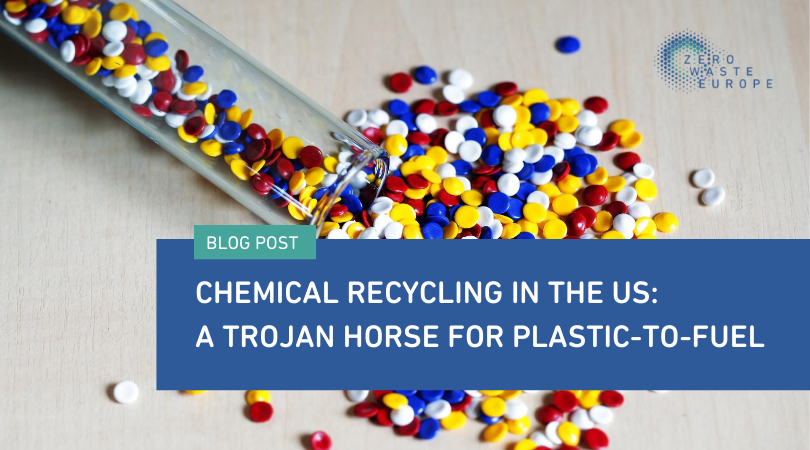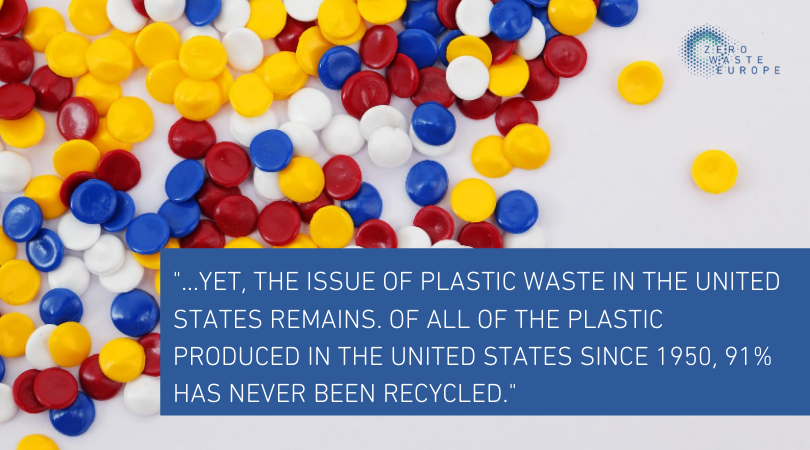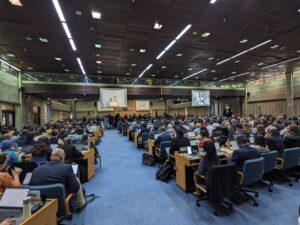Chemical recycling in the US: a Trojan horse for plastic-to-fuel

Our mother organisation, the Global Alliance for Incinerator Alternatives (GAIA), recently published a timely report on the state of chemical recycling in the United States: ‘All Talk and No Recycling’. The title is a fitting summary of its findings. In fact, the assessment found that of the 37 plastic chemical recycling’ facilities planned since the early 2000’s, only 3 are currently operational, and none are successfully recovering plastic to produce new plastics.
Despite the lack of success in commercialising plastic-to-plastic recycling through chemical means, the industry is consistently touting chemical recycling as an alternative solution. In reality, this is often a mislabelling of chemical energy recovery processes like pyrolysis and gasification which aim at recovering polymers or producing hydrocarbons which can be used as fuels; solutions which should be found further down the waste hierarchy as they fail to keep materials in the recycling loop. Chemical recycling is being used as a trojan horse against the global plastic crisis, distracting from the implementation of real solutions like prevention, reuse and efficient recycling methods which are more aligned with the global and national climate goals.
The report also concludes that commercialisation of plastic-to-fuel technologies and their potential impact on the environment, climate, human health and the existing mechanical recycling market is still riddled with uncertainties, without concrete evidence to support the industry’s viability claims. What does seem clear is that in 2019 alone, the global production and incineration of plastic accounted for more than 850 million metric tons of greenhouse gases, approximately equal to the emissions from 189 five-hundred-megawatt coal power plants.
The report also states that plastic-to-fuel technologies, such as pyrolysis and gasification, are energy-intensive processes which place a heavy toxic burden on communities and workers throughout the chemical recovery chain – from the plastic waste processing sites to the final product. As an example, the Agilyx facility in Tigard, Oregon, sent over 49,000 tons of waste styrene, a highly toxic chemical, to burn in cement kilns located in low-income communities (complied predominantly of people of colour) across the country in 2018.
While the world is on a strict carbon diet, the US industry is now lobbying for bills to strengthen the currently weak market for chemically recovered plastic products. By creating a supply chain that leads more waste to plastic-to-fuel facilities, it undermines the less carbon-intensive traditional mechanical recycling markets. For example, legislation introduced in 15 US states would no longer define post-consumer plastic as solid waste and instead reclassifies “chemical” or “advanced recycling” facilities to be regulated as chemical manufacturing facilities that manage products rather than solid waste management – this creates better business opportunities for the industry while reinforcing a business model that relies on the creation of waste.  Yet, the issue of plastic waste in the United States remains. Of all of the plastic produced in the United States since 1950, 91% has never been recycled. However, there is growing momentum to prevent plastic pollution through government bans on plastic bags and other single-use items, with industry partners increasingly calling for strategies to address plastic production. In this context, GAIA identifies an opportunity for fast-moving consumer goods (FMCG) companies to act and leverage real solutions. Public pressure has pushed large corporations to pledge 100% recyclability of packaging by 2030. These pledges must be coupled with commitments for source reduction, or the downstream measures will risk maintaining the current over-production and consumption of plastic packaging. As of July 2020, no FMCG companies had committed to phasing out single-use plastic packaging through a system shift toward reusable and refillable delivery options.
Yet, the issue of plastic waste in the United States remains. Of all of the plastic produced in the United States since 1950, 91% has never been recycled. However, there is growing momentum to prevent plastic pollution through government bans on plastic bags and other single-use items, with industry partners increasingly calling for strategies to address plastic production. In this context, GAIA identifies an opportunity for fast-moving consumer goods (FMCG) companies to act and leverage real solutions. Public pressure has pushed large corporations to pledge 100% recyclability of packaging by 2030. These pledges must be coupled with commitments for source reduction, or the downstream measures will risk maintaining the current over-production and consumption of plastic packaging. As of July 2020, no FMCG companies had committed to phasing out single-use plastic packaging through a system shift toward reusable and refillable delivery options.
Increased investments in non-circular end-of-pipe solutions risk derailing waste prevention efforts. According to petrochemical industry associations, the industry may spend up to $5 billion on plastic recycling in the UnitedStates, about 80% of the announced investments going toward chemical recycling. GAIA expects most of these funds to go towards plastic-to-fuel projects. Given the instability of the fossil fuel market, these are risky investments. Plastic-to-fuel is particularly sensitive to dropping oil prices, as seen in the case of the shutdown of an Agilyx Tigard plant in 2016 when its product failed to compete with the low price of oil costing investors millions of dollars. The fossil divestment trend and era of decarbonization will likely not play out in favour of such fuel recovery endeavours.
The same trend can be seen in Europe, where investment flows and research funding is increasingly being diverted from mechanical to chemical recycling while the legislation hasn’t yet caught up with the technology. With a lack of independent studies of environmental, climate and health impacts of the various chemical recycling methods at industrial level it is still unclear to what extent chemical recycling could be a complement to mechanical recycling. As concluded in Zero Waste Europe’s latest joint statement on chemical recycling: “chemical recycling legislation should take a precautionary approach to ensure prevention measures remain at the core of the EU’s circular economy promises”.
The full GAIA report can be found here.
Do you want to know more about the state of chemical recycling in Europe?
- Discover our latest joint statement with the Rethink Plastic alliance, and notably, ECOS, EEB and HCWH outlines key steps for effective legislation of chemical recycling in the EU.
- Dig into the topic with our study: El Dorado of Chemical Recycling, State of play and policy challenges.
- Read Zoe Casey blog on why chemical recycling won’t solve the plastic crisis.


